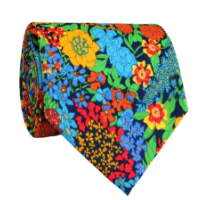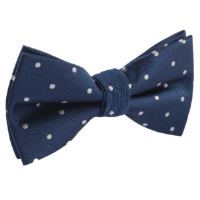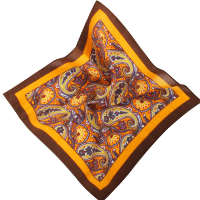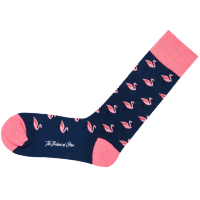What Is the Correct Tie Bar Length?
The correct tie clip or tie bar length has been a relevant conversational topic for the past decade. Modern society has adapted to a broad set of guidelines that dictate the correct length at which you should wear a tie bar.
While this length is widely accepted among fashion circles, only some men have been clued into the memo, so it's common to see people needing to be more mindful of these rules. If you want to appear as a gentleman who truly knows his accessories, understanding the ideal tie bar length is a small but valuable detail worth mastering.

Tie Bar vs. Tie Clip
A tie bar and a tie clip are not the same, though they are similar. A tie clip uses a clasp to secure the tie to the shirt, keeping it firmly in place. A tie bar, on the other hand, slides over the tie and shirt, often focusing more on appearance than on grip. Despite these differences, people still sometimes use the terms interchangeably.

What Is the Correct Tie Clip Size?
The industry's agreed-upon tie clip or tie bar length is ¾ times the width of your tie. The measurement will depend on whether you wear a standard necktie, skinny-tie, or wide tie.
Are all tie bars the same length? No, they should not be. Here are the essential fashion rules:
- Standard ties: For a balanced and polished look, a tie bar length of approximately 5.5 cm (2.1 inches) works best, covering about ¾ of the tie's width.
- Skinny ties: For narrow ties, a tie bar between 2.5 cm (0.9 inches) and 4 cm (1.5 inches) keeps the proportions sharp and well-suited to the tie's width.
- Wide ties: For broader ties, aim for a tie bar around 7.6 cm (3 inches) to maintain balance and complement the tie's dimensions.

A more general rule of thumb is to avoid wearing a tie bar that covers the entire width of your tie. On the other hand, if your tie bar covers half the width of your tie or less, it's too short!
How to Correctly Wear a Tie Bar
Now that we have established the correct length, here's how to put on a tie bar effectively so it stays functional and fashionable:
- Position your tie: Ensure it is properly centred and hanging as you like. If you're wearing a shirt with a pocket, the tie bar will ideally be positioned at about the same level as the pocket.
- Please choose the proper placement: Slide the tie bar horizontally across both layers of the tie (the front and the back) and secure it to the placket of your shirt underneath. This ensures that the tie bar keeps your tie and shirt together and prevents your tie from shifting.
- Adjust the angle: Align the tie bar so it's parallel to the ground, avoiding any slant. A straight tie bar gives a cleaner, more polished appearance.
- Check for functionality: Tug your tie to ensure it's fastened securely. This will prevent the tie from pulling away from your shirt, especially if you're not wearing a jacket over it.

Where Does a Tie Bar Go?
You might wonder, "Where should a tie clip go?" The answer is simple. Place your tie bar between your dress shirt's third and fourth buttons to achieve a polished look. This positioning maintains visibility without crowding the knot and collar, preventing your jacket from hiding the tie bar. If you're in a rush, aim for about ¼ of the way down your tie.
Always fasten your tie clip or tie bar to the tie lengths and the shirt seam to keep your tie neatly in place. Consider using collar stays to keep your collar crisp alongside your tie bar for added sharpness. Hence, you look sharp and ready for anything.
Frequently Asked Questions
What is the standard tie length?
The standard tie length for most ties is around 145-152 cm (57-60 inches), which typically suits men up to 1.8 meters (6 feet) tall.
How do you measure a tie bar?
To measure a tie bar, place it along the width of your tie, ideally covering about ¾ of its width to achieve the best look.
What is the minimum size for a tie bar?
The minimum size for a tie bar is typically around 3.8 cm (1.5 inches), which works well for skinny ties.
Can a tie bar be longer than the tie?
A tie bar should never be longer than the width of the tie; ideally, it should cover no more than ¾ of the tie's width for a balanced look.






